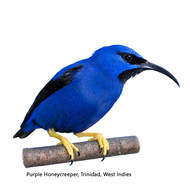|
The purple honeycreeper (Cyanerpes caeruleus) is a small bird in the tanager family. It is found in the tropical New World from Colombia and Venezuela south to Brazil, and on Trinidad. A few, possibly introduced birds have been recorded on Tobago.
The purple honeycreeper is 11.5 cm long, weighs 12 g and has a long black decurved bill. The male is purple with black wings, tail and belly, and bright yellow legs. Females and immatures have green upperparts, and green-streaked yellowish-buff underparts. The throat is cinnamon, and there is a blue moustachial stripe. The call of purple honeycreeper is a thin high-pitched zree. The Trinidadian subspecies C. c. longirostris has a longer bill than the mainland forms. This is a forest canopy species, but also occurs in cocoa and citrus plantations. At the upper limit of its altitudinal range, it frequents premontane rainforest, usually rather low-growing (10–15 m) and full of epiphytes and mosses. The purple honeycreeper is often found in small groups. It feeds on nectar (particularly from bromeliad and similar flowers, to which its bill shape is adapted), berries and insects, mainly in the canopy. It is a bold and inquisitive bird, responding readily to the call of the ferruginous pygmy owl (Glaucidium brasilianum) by coming out of cover and searching for the presumed predator to mob it. The female purple honeycreeper builds a small cup nest in a tree, and incubates the clutch of two brown-blotched white eggs. Purple honeycreeper photographed by Rachel Lee Young at Yerette Hummingbird Sanctuary, Maracas St Joseph.
0 Comments
Leave a Reply. |
AuthorRachel Lee Young. Photographer Archives
January 2020
Categories |


 RSS Feed
RSS Feed
